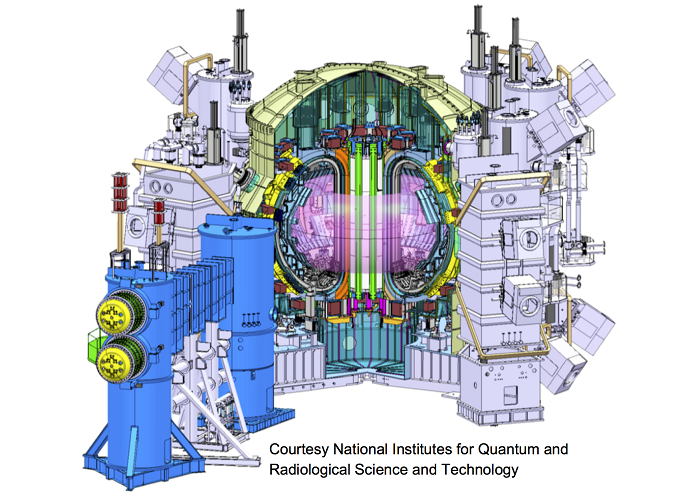SHINOHARA Kouji
(Professor/Division of Transdisciplinary Sciences)
Department of Complexity Science and Engineering/Plasma Physics and Nuclear Fusion

Career Summary
Mar. 1992: Graduated, Faculty of Engineering (University of Tokyo)
Mar. 1997: Graduated, Department of Physics, Graduate School of Science, University of Tokyo (Science Doctorate from University of Tokyo)
Apr. 1997: Post doctoral fellow, Japan Atomic Energy Research Institute
Mar. 1998: Researcher, Japan Atomic Energy Research Institute
Apr. 2005: Senior Researcher, Japan Atomic Energy Research Institute
Oct. 2005: Senior Researcher, Japan Atomic Energy Agency (The name of the institute have just been changed in Oct. 2005)
Jul. 2009: Principal Researcher, Japan Atomic Energy Agency
Apr. 2016: Senior Principal Researcher, National Institutes for Quantum and Radiological Science and Technology (The name of the institute and the job tile have just been changed. But the position is same level.)
Jul. 2020: Professor, The University of Tokyo
Educational Activities
Graduate school:Elementary Course of Experiments on Complexity Science and Engineering
Research Activities
In the space far from the Sun, say beyond the orbit of Mars, where the energy supply from the Sun is very limited, our spacecrafts and settlements have to rely on the energy from nuclear reactions.
One of the reactions, nuclear fission, is difficult to sustain since it is almost impossible to find its fuel, uranium or other heavy atoms.
On the other hand, the fuel of fusion reactions ? hydrogen ? is widely available in the Universe. (In fact, hydrogen is the source of the power of the Sun.)
We should secure such an ultimate energy source, nuclear fusion, to sustain "human civilization" in the long run.
I have engaged in the research on the plasma physiscs and worked for ITER (see below) in order to contribute to the realization of the nuclear fusion [e.g. 1-3].
In 2020s, we will proceed to the next stage by operating new two new experimental machines: ITER and JT-60SA.
ITER is being built in France by an international collaboration (EU, Japan, US, Russia, China, South Korea, India) and will start its operation in 2025[4]. ITER is the largest machine in the world. We will have controlled burning plasmas in ITER for the first time (in human history).
JT-60SA is the second largest machine. It is designed to explore more challenging operation scenarios than permitted on ITER. JT-60SA is about to start its operation in Japan through a collaboration between Japan and EU[5].
We can say we are in a really exciting moment.
I and other faculty members of the "Nuclear Fusion Research Education Program" would like to foster young scientists who can enjoy and lead these big projects.
For this purpose, my laboratory utilizes the spherical tokamak, TST-2, collaborating with the Ejiri-Tsujii Lab in Kashiwa campus and other facilities (JT-60SA, JT-60U, LHD, QUEST) under collaborations with QST*, NIFS* and other universities.
*)
QST: National Institutes for Quantum Science and Technology in Japan;
NIFS: National Institute for Fusion Science in Japan

JT-60SA (QST). The largest tokamak in the world until the ITER starts
its operation. The donuts shape with thin pink color is the image of
its plasma. The maximum diameter is 8m[cited from 5].
Literature
1) K. Shinohara, et al., Nuclear Fusion, vol 51 063028 (2011).
2) K. Shinohara, et al., Nuclear Fusion, 58, 082026 (2018)
3) A. Bierwage, et al., Nature Communications, 9, 3282 (2018)
4) https://www.iter.org/
5) https://www.qst.go.jp/site/jt60-english/
6) Takase Y, et al. Nucl. Fusion 41,1543 (2001)
Other Activities
The Physical Society of Japan (JPS)
The Japan Society of Plasma Science and Nuclear Fusion Research (JSPF)
Member of Nuclear Fusion Plasma area comittee of the JSPF
Member of program committee of IAEA Technical Meeting on Energetic Particles in Magnetic Confinement Systems
Member of International Tokamak Physics Activity (ITPA) "Energetic particle physics Topical group"
Organizer of the subsluster "MHD & Energetic particle physics" Fusion Energy Forum of Japan
Technical Responsible Officer for "High energy particle physics" in JT-60SA research plan (2009-2021)
Member of Board of Directors of the JSPF(2019-2021)
Chair, public relations commitee of the JSPF (2020-2021)
Future Plan
JT-60SA will improve its performance campain by campain. The reseach items in the first priority is different in the each campain.
We will develop a code or model based on the knowledge obtained by the first campain. We will validate and improve the code or model in the next campain.
We hope the code or model will contribute to ITER experiments and a design for a DEMO.
Messages to Students
We are in an exciting phase toward the realization of the nuclear fusion to contribute to the long-lasting "human civilization". It is the era of the new big projects, ITER and JT-60SA. Our community hope to have young generation to lead these projects. Don't you challenge the grand reaseach activity ?
